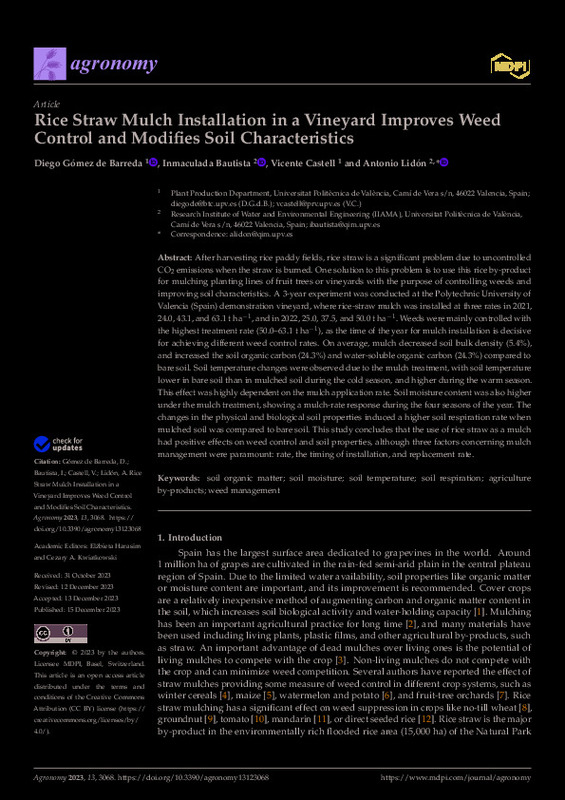JavaScript is disabled for your browser. Some features of this site may not work without it.
Buscar en RiuNet
Listar
Mi cuenta
Estadísticas
Ayuda RiuNet
Admin. UPV
Rice Straw Mulch Installation in a Vineyard Improves Weed Control and Modifies Soil Characteristics
Mostrar el registro sencillo del ítem
Ficheros en el ítem
| dc.contributor.author | Gómez De Barreda, Diego
|
es_ES |
| dc.contributor.author | Bautista, Inmaculada
|
es_ES |
| dc.contributor.author | Castell-Zeising, Vicente
|
es_ES |
| dc.contributor.author | Lidón, Antonio
|
es_ES |
| dc.date.accessioned | 2024-01-05T19:01:41Z | |
| dc.date.available | 2024-01-05T19:01:41Z | |
| dc.date.issued | 2023-12-15 | es_ES |
| dc.identifier.uri | http://hdl.handle.net/10251/201536 | |
| dc.description.abstract | [EN] After harvesting rice paddy fields, rice straw is a significant problem due to uncontrolled CO2 emissions when the straw is burned. One solution to this problem is to use this rice by-product for mulching planting lines of fruit trees or vineyards with the purpose of controlling weeds and improving soil characteristics. A 3-year experiment was conducted at the Polytechnic University of Valencia (Spain) demonstration vineyard, where rice-straw mulch was installed at three rates in 2021, 24.0, 43.1, and 63.1 t ha¿1, and in 2022, 25.0, 37.5, and 50.0 t ha¿1. Weeds were mainly controlled with the highest treatment rate (50.0¿63.1 t ha¿1), as the time of the year for mulch installation is decisive for achieving different weed control rates. On average, mulch decreased soil bulk density (5.4%), and increased the soil organic carbon (24.3%) and water-soluble organic carbon (24.3%) compared to bare soil. Soil temperature changes were observed due to the mulch treatment, with soil temperature lower in bare soil than in mulched soil during the cold season, and higher during the warm season. This effect was highly dependent on the mulch application rate. Soil moisture content was also higher under the mulch treatment, showing a mulch-rate response during the four seasons of the year. The changes in the physical and biological soil properties induced a higher soil respiration rate when mulched soil was compared to bare soil. This study concludes that the use of rice straw as a mulch had positive effects on weed control and soil properties, although three factors concerning mulch management were paramount: rate, the timing of installation, and replacement rate. | es_ES |
| dc.description.sponsorship | This research was funded by the Ministerio de Ciencia, Innovación y Universidades and the Agencia Estatal de Investigación, grant number RTC-2017-6249-2 titled ¿Desarrollo de un nuevo insumo para la agricultura sostenible: mulch de paja de arroz con incorporación de bacterias promotoras del crecimiento de las plantas (PGPB) y mecanización integral de procesos (SMART MULCH)¿. | es_ES |
| dc.language | Inglés | es_ES |
| dc.publisher | MDPI | es_ES |
| dc.relation.ispartof | Agronomy | es_ES |
| dc.rights | Reconocimiento (by) | es_ES |
| dc.subject | Soil organic matter | es_ES |
| dc.subject | Soil moisture | es_ES |
| dc.subject | Soil temperature | es_ES |
| dc.subject | Soil respiration | es_ES |
| dc.subject | Agriculture by-products | es_ES |
| dc.subject | Weed management | es_ES |
| dc.subject.classification | PRODUCCION VEGETAL | es_ES |
| dc.subject.classification | EDAFOLOGIA Y QUIMICA AGRICOLA | es_ES |
| dc.title | Rice Straw Mulch Installation in a Vineyard Improves Weed Control and Modifies Soil Characteristics | es_ES |
| dc.type | Artículo | es_ES |
| dc.identifier.doi | 10.3390/agronomy13123068 | es_ES |
| dc.relation.projectID | info:eu-repo/grantAgreement/AGENCIA ESTATAL DE INVESTIGACION//RTC-2017-6249-2-AR//DESARROLLO DE UN NUEVO INSUMO PARA LA AGRICULTURA SOSTENIBLE: MULCH DE PAJA DE ARROZ CON INCORPORACIÓN DE BACTERIAS PROMOTORAS DEL CRECIMIENTO DE LAS LANTAS (PGPB) Y MECANIZACIÓN INTEGRAL DE PROCESOS/ | es_ES |
| dc.rights.accessRights | Abierto | es_ES |
| dc.contributor.affiliation | Universitat Politècnica de València. Escuela Técnica Superior de Ingeniería Agronómica y del Medio Natural - Escola Tècnica Superior d'Enginyeria Agronòmica i del Medi Natural | es_ES |
| dc.description.bibliographicCitation | Gómez De Barreda, D.; Bautista, I.; Castell-Zeising, V.; Lidón, A. (2023). Rice Straw Mulch Installation in a Vineyard Improves Weed Control and Modifies Soil Characteristics. Agronomy. 13(12):1-12. https://doi.org/10.3390/agronomy13123068 | es_ES |
| dc.description.accrualMethod | S | es_ES |
| dc.relation.publisherversion | https://doi.org/10.3390/agronomy13123068 | es_ES |
| dc.description.upvformatpinicio | 1 | es_ES |
| dc.description.upvformatpfin | 12 | es_ES |
| dc.type.version | info:eu-repo/semantics/publishedVersion | es_ES |
| dc.description.volume | 13 | es_ES |
| dc.description.issue | 12 | es_ES |
| dc.identifier.eissn | 2073-4395 | es_ES |
| dc.relation.pasarela | S\506259 | es_ES |
| dc.contributor.funder | AGENCIA ESTATAL DE INVESTIGACION | es_ES |
| dc.subject.ods | 02.- Poner fin al hambre, conseguir la seguridad alimentaria y una mejor nutrición, y promover la agricultura sostenible | es_ES |
| dc.subject.ods | 15.- Proteger, restaurar y promover la utilización sostenible de los ecosistemas terrestres, gestionar de manera sostenible los bosques, combatir la desertificación y detener y revertir la degradación de la tierra, y frenar la pérdida de diversidad biológica | es_ES |








